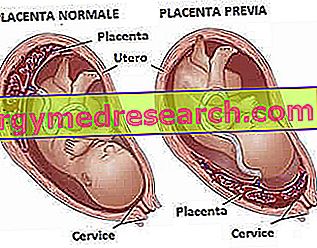Generality
We talk about placenta previa when the placenta grows at the bottom of the uterus, at the cervix. Not all previous placentas are presented in the same way: in some cases, the opening between the uterus and vagina is covered (more serious eventuality); in other cases, the placenta is placed, only, next to the opening.

Figure: comparison between a normal placenta and a placenta previa. From the site: riversideonline.com
More than a precise cause, risk factors have been recognized. The main symptom, which is also fundamental for the diagnosis, is blood loss from the vagina.
The therapy consists in adopting the most suitable measures to save the life of the mother and the fetus.
In this sense, early diagnosis and timely intervention are fundamental for a positive prognosis.
Brief anatomical reference: placenta and uterus
To better understand what happens in the placenta previa, it is necessary to make a brief anatomical review of the placenta and uterus.
THE PLACENTA
The placenta is formed inside the uterus, during a pregnancy, to nourish, protect and support the growth of the fetus. It is therefore a temporary or deciduous organ.
The placenta has a dual origin: maternal and fetal. The maternal component derives from the endometrium of the uterus ; the fetal component corresponds to the chorionic villi .
The chorionic villi are branched extensions of the placenta, which sink into the uterus (inside the "lacunae"), to withdraw the nutrients and oxygen from the mother's blood vessels. At this point, nourishment and oxygen convey towards the umbilical cord and, from here, reach the fetus.
POSITION AND DIMENSIONS OF THE PLACENTA
The placenta can grow in any position within the uterus.
At the end of pregnancy, the placenta has the following characteristics:
- It is blue-red in color and discoid in shape
- The diameter measures between 15 and 22 centimeters
- The thickness varies between 2 and 4 centimeters
- It weighs 500-600 grams (15% of the weight of the newborn)
MAIN FUNCTIONS OF THE PLACENTA
The placenta is essential for the survival and growth of the fetus. In fact, it is a multifunctional organ: it acts as a lung, kidney, digestive system, immune system and protective barrier.

The WOMB
The uterus is the female genital organ, which welcomes the fetus during a pregnancy. It is found in the small pelvis, precisely between bladder (anteriorly), rectal intestine (posteriorly), intestinal loops (superiorly) and vagina (inferiorly).
In the uterus two areas can be recognized: the body of the uterus and the cervix uterine (or cervix ).
The body is the upper portion of the uterus.
The cervix, on the other hand, is the lower portion, which connects to the vagina. It is cylindrical in shape and is provided with an opening (or orifice), between the uterus and vagina, which allows the passage of spermatozoa, the menstrual flow and the fetus (during birth).
What is placenta previa
Placenta previa means the circumstance in which the placenta grows in the lower part of the uterus, in correspondence of the cervix .

Placenta previa, together with placental detachment, is one of the main causes of antepartum hemorrhage, which, in turn, is one of the main reasons for maternal and fetal death.
NB: antepartum hemorrhage is considered to be any vaginal bleeding that occurs from the 24th week of gestation.
DEGREE OF PLACENTA PREVIA
Based on the position taken by the placenta in the uterine cervix, there are four possible types of placenta previa:
Grade I
Characteristics: the placenta grows in the lower portion of the uterus, but is distant from the opening of the cervix, which connects the uterus and the vagina.
Grade II
Characteristics: the placenta is positioned on the margin of the utero-vaginal opening of the cervix.
Grade III
Characteristics: the placenta covers a part of the utero-vaginal opening of the cervix.
Grade IV
Characteristics: the placenta covers the entire uterus-vaginal opening of the cervix.

The severity of the placenta previa increases with increasing degree. Grade I episodes are therefore less dangerous for the survival of the mother and the fetus, compared to episodes of grade II, which in turn are less dangerous than episodes of grade III or IV.
Epidemiology
The placenta previa, in all its manifestations, occurs with an incidence equal to one case for every 200 pregnancies. The grade IV form, the most dangerous, is much rarer and affects one pregnant woman every 1000.
About 1/3 of antepartum hemorrhage is caused by placenta previa, which is also the cause of about 2-3% of perinatal deaths .
NB: the perinatal period is the one that goes from the 27th week of gestation to the first 28 days of life of the newborn.
Causes of placenta previa
The precise cause of placenta previa is not known. However, it was found that certain circumstances, concerning the mother, favor its occurrence. But what are these favoring situations?
RISK FACTORS
The risk factors are different and, often, to be decisive, they must be concomitant with each other. In other words, the single event may not be enough, but an overlapping of more favorable conditions may be needed.
In the list of risk factors, appear:
- Previous episodes of placenta previa .
- Advanced age of the mother .
Over 35-40 years old
- Previous uterine surgery .
They are cesarean delivery and uterine fibroid surgery.
- Abnormal shape of the uterus .
An unusual anatomy of the uterus could favor the incorrect position of the placenta
- Smoking and drug abuse .
Smoking during pregnancy or using drugs, such as cocaine, predisposes women to abnormal placenta formation.
- Multiple pregnancy .
In these cases, the placenta can be extensive and consequently invade the cervix.
- Previous spontaneous or induced abortions .
CONTINUE: Placenta Previa - Symptoms, Diagnosis and Therapy »



